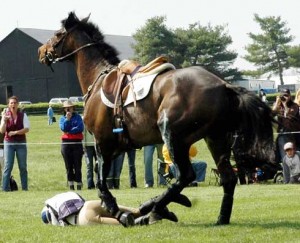Calculating the Risk
By Peggy Hosking February 1, 2011A recent court ruling could upend existing case law when it comes to trainer responsibility in the case of student injury or death.
Mia Eriksson of Tahoe City died shortly after her horse crushed her during the cross-country phase of an event at Galway Downs, Temecula, in November 2006. It was not the first fall for the 7-year-old horse and the 17-year-old rider.
According to court papers filed in Riverside County, the horse also fell two weeks earlier while on course at Ram Tap. A vet at that time noted that the horse should be seen by his regular vet and monitored for possible head trauma. The horse was taken home, his shoes pulled and his feed changed: He was not going to be competing anymore that season. The horse reportedly had not been training during the two weeks that elapsed between Ram Tap and Galway Downs.
Mia’s parents sued her trainer for wrongful death and negligent infliction of emotional distress. In the eyes of the law, anyone competing on horseback assumes some risk of harm. But Mia’s parents alleged that the trainer unreasonably increased that risk by allowing Mia to compete on a horse that was unfit to ride.
A Riverside County trial court found in favor of the trainer and dismissed the case in a summary judgment. The Erikssons appealed, and the appellate court agreed with the parents. The case has been kicked back to county court: The trainer will face a trial to determine her liability.
The appellate court stated that the trainer “had a duty not to unreasonably increase the risk inherent in the cross-country event by allowing Mia to ride a horse that was not fit.” (Eriksson v. Nunnink (2011) Fourth District, Division Two, E049392). The appellate court went on to say that the trainer “had some responsibility for the fitness of the horse and had the ability to control whether the horse participated in the cross-country event.” One of the issues to be decided at the trial is whether the fitness or the condition of the horse contributed to the fall that resulted in Mia’s death.
Riders know that equestrian sports are dangerous. We are constantly signing releases of liability; they remind us that our sport is dangerous. Although the general principle is that we all have a responsibility to not increase the risk of harm to someone else, California courts apply the doctrine of “primary assumption of the risk” to most cases involving sports, including equestrian sports. That is to say that the participant knows of the risks inherent to the sport and chooses to participate willingly, even after consideration of the risks, and therefore in broad terms should not have the ability to recover damages in the event of injury.
However, it is also well settled law that:
1) A release of liability “purporting to release liability for future gross negligence, generally is unenforceable as a matter of public policy.” (City of Santa Barbara v. Superior Court (2007) 41 Cal.4th 747, 751)
2) A coach has a duty of ordinary care not to increase the risk of injury to a student by encouraging or allowing the student to participate in the sport when he or she is physically unfit to participate or by allowing the student to use unsafe equipment or instruments. (Tan v. Goddard (1993) 13 Cal.App.4th 1528, 1535-1536; Wattenbarger v. Cincinnati Reds, Inc. (1994) 28 Cal.App.4th 746, 755).
In this case, the appellate court also opined that “the release executed by the Erikssons does not preclude the Erikssons’ actions against [the trainer] to the extent they are based upon aggravated misconduct by [the trainer].” (Eriksson, supra at pp. 31 and 46.) The appeals court said trainers “can be sued for falsehoods that lead an athlete to take greater risks.”
While it remains to be seen whether a jury will award damages to the Erikssons, at a minimum this case may open the door for increased liability to trainers if they encourage or allow their students to ride, whether in competition or not, if, as an experienced trainer, they knew or should have known that either horse or rider is not fit for the intended level of activity or that the horse is unsafe for the activity for which the rider is using the horse.
If the trial court rules in favor of the parents, the trainer could potentially appeal. (If denied by the appellate court, an application could be made to the California Supreme Court for review, which would not likely be given.)
Although the trainer has not yet been found liable, it is clear from the appellate court ruling that the court will hold trainers to a higher standard of care for their students and therefore, trainers should exercise caution when dealing with circumstances in which there is an increased risk of harm to their students.
Peggy Hosking is an avid equestrian and business attorney at Best Best & Krieger LLP in Riverside, Calif.
Editor’s note: Trainer Kristi Nunnink was represented in the aforementioned action by attorney James Sonne. In an unrelated incident three years prior to Mia’s death, the Erikssons, who own a stable in Truckee, lost their 18-year-old daughter, Shana, as the result of a riding accident at Cal State Fresno, where she was on the equestrian team.
Short URL: https://theequestriannews.com/?p=2519



